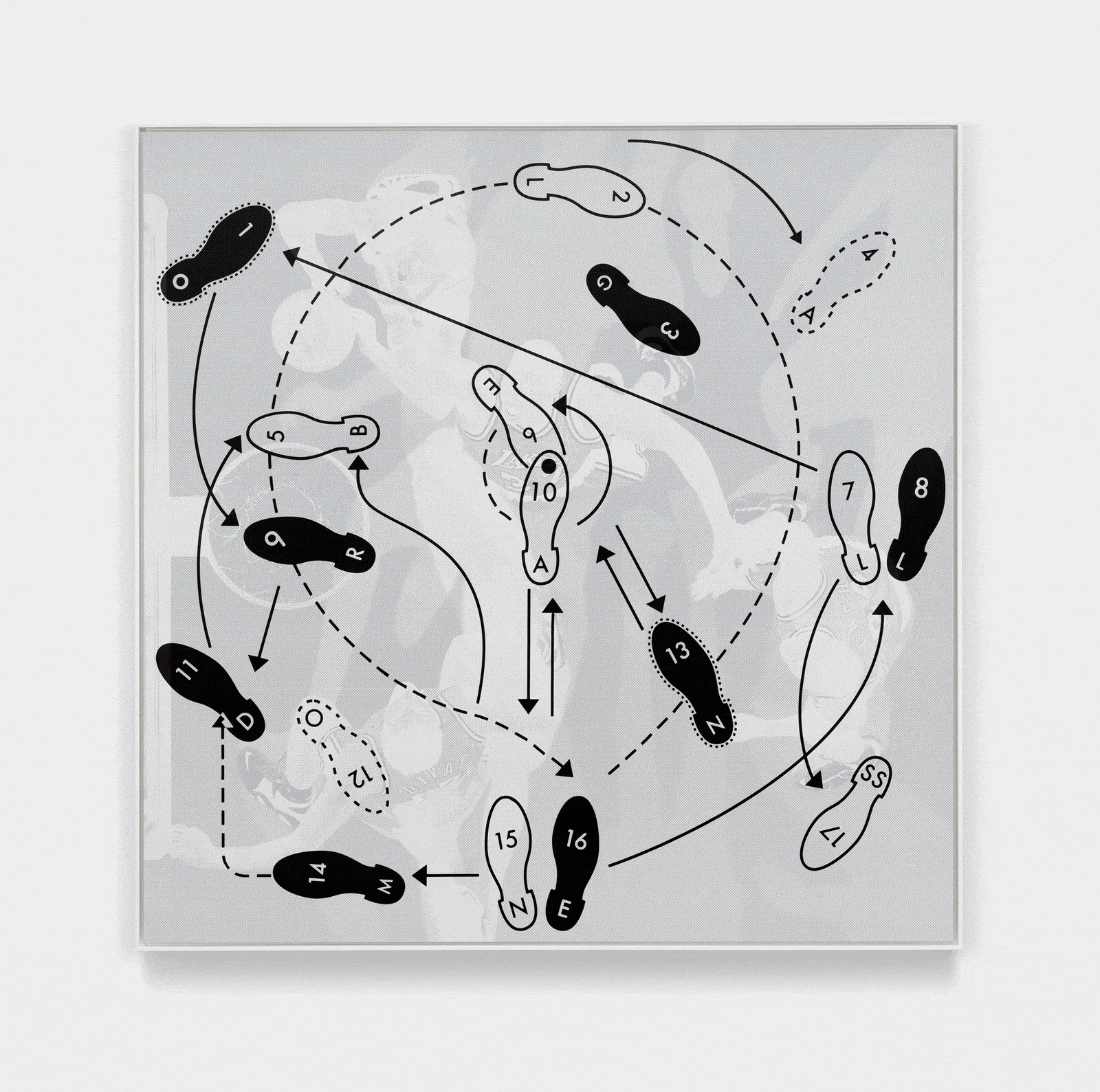
Hank Willis Thomas American, 1976
Rebound, 2023
UV print on retroreflective vinyl, mounted on Dibond
121.9 x 121.9 cm. (48 x 48 in.)
Copyright The Artist
Further images
In Rebound (2023), Hank Willis Thomas uses retroreflective materials to create a dynamic, responsive visual experience. The work relies on viewer movement and light conditions to reveal its full image....
In Rebound (2023), Hank Willis Thomas uses retroreflective materials to create a dynamic, responsive visual experience. The work relies on viewer movement and light conditions to reveal its full image. Under standard lighting, it presents a diagram reminiscent of Andy Warhol’s Dance Diagram series (early 1960s), which reproduced instructional dance steps from manuals. Thomas echoes this with shoe prints marked “right” and “left,” suggesting choreographed motion.
When illuminated with a flashlight, a second image surfaces: the Los Angeles Lakers mid-slam dunk, viewed from above. The diagram’s foot patterns align with the basketball players’ movements, linking dance and sport through shared language of physicality and rhythm.
This relationship between visibility and concealment invites reconsideration of how art demands participation. Warhol’s diagrams implied viewer activation through dance; Thomas requires literal engagement with light to access the complete image. In doing so, he expands the role of the viewer from passive observer to active participant.
Thomas often interrogates American visual culture, and here he collapses boundaries between high art and popular culture. By pairing dance notation with basketball imagery, Rebound foregrounds the choreographed nature of both forms and challenges their traditional cultural separation. The choice of the Lakers – a team with deep ties to Black excellence and media spectacle – anchors the work in broader conversations about race, representation, and the aesthetics of athleticism.
The act of revelation itself becomes metaphorical. What is seen only under scrutiny reflects the often-unacknowledged artistry within sport. Rebound prompts viewers to reconsider not just what they’re seeing, but how – and under what conditions – they are allowed to see.
Thomas is known for appropriating and recontextualising images from advertising, media, and sport to explore themes of identity, race, and power. Rebound continues this trajectory, offering a complex meditation on perception, visibility, and cultural value.
When illuminated with a flashlight, a second image surfaces: the Los Angeles Lakers mid-slam dunk, viewed from above. The diagram’s foot patterns align with the basketball players’ movements, linking dance and sport through shared language of physicality and rhythm.
This relationship between visibility and concealment invites reconsideration of how art demands participation. Warhol’s diagrams implied viewer activation through dance; Thomas requires literal engagement with light to access the complete image. In doing so, he expands the role of the viewer from passive observer to active participant.
Thomas often interrogates American visual culture, and here he collapses boundaries between high art and popular culture. By pairing dance notation with basketball imagery, Rebound foregrounds the choreographed nature of both forms and challenges their traditional cultural separation. The choice of the Lakers – a team with deep ties to Black excellence and media spectacle – anchors the work in broader conversations about race, representation, and the aesthetics of athleticism.
The act of revelation itself becomes metaphorical. What is seen only under scrutiny reflects the often-unacknowledged artistry within sport. Rebound prompts viewers to reconsider not just what they’re seeing, but how – and under what conditions – they are allowed to see.
Thomas is known for appropriating and recontextualising images from advertising, media, and sport to explore themes of identity, race, and power. Rebound continues this trajectory, offering a complex meditation on perception, visibility, and cultural value.
